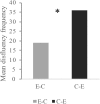Predicting Fluency With Language Proficiency, Working Memory, and Directionality in Simultaneous Interpreting
- PMID: 30186213
- PMCID: PMC6110880
- DOI: 10.3389/fpsyg.2018.01543
Predicting Fluency With Language Proficiency, Working Memory, and Directionality in Simultaneous Interpreting
Abstract
Simultaneous interpreting (SI) is a complex bilingual verbal activity that poses great challenges for working memory (WM) and language proficiency. Fluency is one of the crucial indicators in evaluating SI quality, the violation of which is characterized by disfluency indicators such as interruptions, hesitations, repetitions, corrections, and blanks. To uncover factors underlying fluency in SI, 22 interpreting students performed a battery of tasks to test their language proficiency and WM. Two SI tasks, both from Chinese to English and from English to Chinese, were also conducted, and fluency was evaluated according to the five indicators. Two factors (language proficiency and WM) and the five objectively measured disfluency indicators were then used as input for a regression analysis in both directions to model factors underlying fluency in SI performance. The results reveal that, with fluency measured as a whole, WM and directionality yield a significant effect on fluency, and that WM is the only variable that predicts fluency in both directions, accounting for 50 and 51% of the variation in the occurrence of disfluencies in Chinese-English and English-Chinese interpreting, respectively. The findings clarify for the first time the role of language proficiency, WM, and directionality upon fluency in SI, indicating the critical role of WM capability as compared with language skills in fluent production. The research also supports the position that, for interpreting students, interpreting performance tends to be more fluent in the non-native to native language direction.
Keywords: directionality; fluency; language proficiency; simultaneous interpreting; working memory.
Figures






Similar articles
-
The Predicting Power of Cognitive Fluency for the Development of Utterance Fluency in Simultaneous Interpreting.Front Psychol. 2020 Aug 4;11:1864. doi: 10.3389/fpsyg.2020.01864. eCollection 2020. Front Psychol. 2020. PMID: 32903742 Free PMC article.
-
Speech Disfluencies in Consecutive Interpreting by Student Interpreters: The Role of Language Proficiency, Working Memory, and Anxiety.Front Psychol. 2022 May 27;13:881778. doi: 10.3389/fpsyg.2022.881778. eCollection 2022. Front Psychol. 2022. PMID: 35712188 Free PMC article.
-
A case study of bilingual neurogenic stuttering: Measures of fluency, emotion, and articulation rate.J Commun Disord. 2024 Jan-Feb;107:106385. doi: 10.1016/j.jcomdis.2023.106385. Epub 2023 Dec 8. J Commun Disord. 2024. PMID: 38065050
-
Poorer verbal working memory for a second language selectively impacts academic achievement in university medical students.PeerJ. 2013 Feb 12;1:e22. doi: 10.7717/peerj.22. Print 2013. PeerJ. 2013. PMID: 23638357 Free PMC article.
-
Emotional and Non-Emotional Verbal Fluency in Native and Non-Native Speakers.Arch Clin Neuropsychol. 2022 Jan 17;37(1):199-209. doi: 10.1093/arclin/acab031. Arch Clin Neuropsychol. 2022. PMID: 33969381
Cited by
-
Speech errors in consecutive interpreting: Effects of language proficiency, working memory, and anxiety.PLoS One. 2023 Oct 18;18(10):e0292718. doi: 10.1371/journal.pone.0292718. eCollection 2023. PLoS One. 2023. PMID: 37851699 Free PMC article.
-
Effects of Directionality on Interpreting Performance: Evidence From Interpreting Between Chinese and English by Trainee Interpreters.Front Psychol. 2021 Nov 26;12:781610. doi: 10.3389/fpsyg.2021.781610. eCollection 2021. Front Psychol. 2021. PMID: 34899532 Free PMC article.
-
Informativeness across Interpreting Types: Implications for Language Shifts under Cognitive Load.Entropy (Basel). 2023 Jan 28;25(2):243. doi: 10.3390/e25020243. Entropy (Basel). 2023. PMID: 36832610 Free PMC article.
-
Effects of executive functions on consecutive interpreting for Chinese-Japanese unbalanced bilinguals.Front Psychol. 2023 Aug 31;14:1236649. doi: 10.3389/fpsyg.2023.1236649. eCollection 2023. Front Psychol. 2023. PMID: 37727743 Free PMC article.
-
Cognitive and Linguistic Predictors of Bilingual Single-Word Translation.J Cult Cogn Sci. 2020 Oct;4(2):145-164. doi: 10.1007/s41809-020-00061-6. Epub 2020 Jul 12. J Cult Cogn Sci. 2020. PMID: 33615138 Free PMC article.
References
-
- Akbari A., Segers W. (2017). Translation difficulty: how to measure and what to measure. Lebende Sprachen 62 3–29. 10.1515/les-2017-0002 - DOI
-
- Barrouillet P., Camos V. (2012). As time goes by: temporal constraints in working memory. Curr. Dir. Psychol. Sci. 21 413–419. 10.1177/0963721412459513 - DOI
-
- Blasco Mayor M. J. (2015). L2 proficiency as predictor of aptitude for interpreting: an empirical study. Transl. Interpret. Stud. 10 108–132. 10.1075/tis.10.1.06bla - DOI
-
- Bühler H. (1986). Linguistic (semantic) and extra-linguistic (pragmatic) criteria for the evaluation of conference interpretation and interpreters. Multilingua 5 231–235. 10.1515/mult.1986.5.4.231 - DOI
LinkOut - more resources
Full Text Sources
Other Literature Sources

